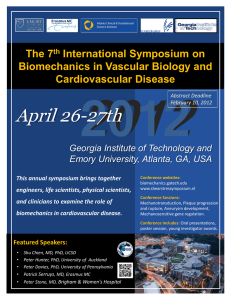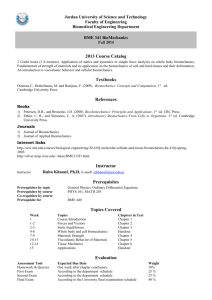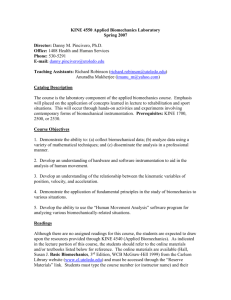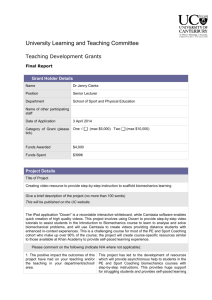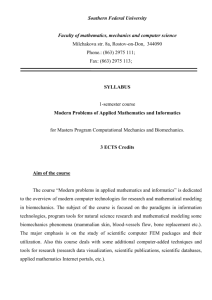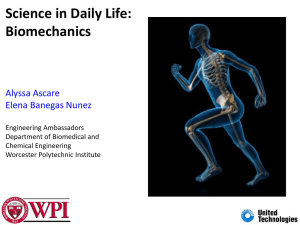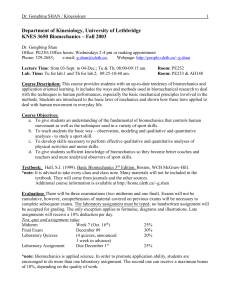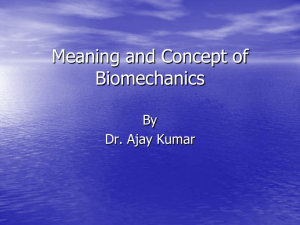ASB 2012 Tutorials and Tours
advertisement
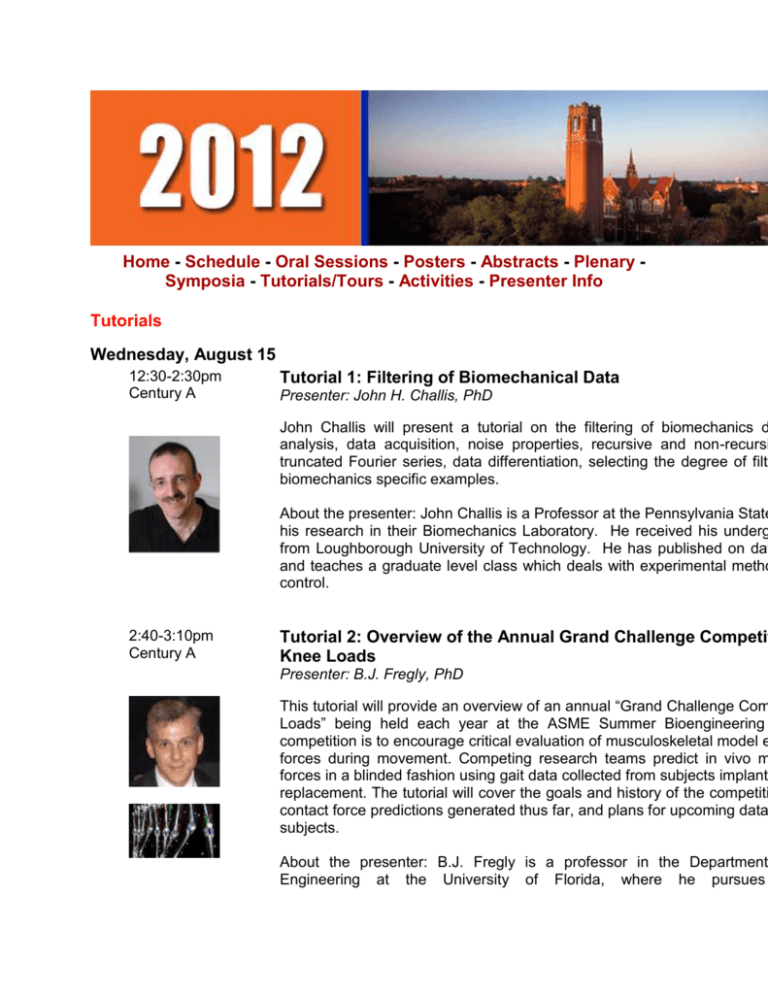
Home - Schedule - Oral Sessions - Posters - Abstracts - Plenary Symposia - Tutorials/Tours - Activities - Presenter Info Tutorials Wednesday, August 15 12:30-2:30pm Century A Tutorial 1: Filtering of Biomechanical Data Presenter: John H. Challis, PhD John Challis will present a tutorial on the filtering of biomechanics d analysis, data acquisition, noise properties, recursive and non-recursi truncated Fourier series, data differentiation, selecting the degree of filte biomechanics specific examples. About the presenter: John Challis is a Professor at the Pennsylvania State his research in their Biomechanics Laboratory. He received his underg from Loughborough University of Technology. He has published on dat and teaches a graduate level class which deals with experimental metho control. 2:40-3:10pm Century A Tutorial 2: Overview of the Annual Grand Challenge Competit Knee Loads Presenter: B.J. Fregly, PhD This tutorial will provide an overview of an annual “Grand Challenge Com Loads” being held each year at the ASME Summer Bioengineering competition is to encourage critical evaluation of musculoskeletal model e forces during movement. Competing research teams predict in vivo m forces in a blinded fashion using gait data collected from subjects implant replacement. The tutorial will cover the goals and history of the competiti contact force predictions generated thus far, and plans for upcoming data subjects. About the presenter: B.J. Fregly is a professor in the Department Engineering at the University of Florida, where he pursues neuromusculoskeletal biomechanics. He received his undergraduate de and his graduate degrees from Stanford University. His publications have patient-specific walking models to design improved treatments for neurom 3:20-4:20pm Century A Tutorial 3: Measuring 3D Skeletal Kinematics Using Radiogra Presenters: Scott A. Banks, PhD; Shang Mu, PhD The purpose of this tutorial will be to introduce participants to the basic measurement from radiographic images, and to show examples of how th in a variety of different research contexts. Examples of single- and ste covered, as well as methods for performing measurements with natura metallic markers, and with joint replacement implants. About the presenters: Scott Banks teaches in the Department of Mechanic the University of Florida, and directs the Orthopaedic Biomechanics Labo skeletal kinematics using radiographic images since 1989. Shang M University of Florida in 2010, in part for his work developing JointTrack, o image registration for skeletal kinematic measurements from radiograph Software Engineer at MAKO Surgical Corp. Lab Tours Tours to cover five labs spanning Departments of Orthopaedics, Applied Physiology and Kinesiology, and the Brain Rehabilitation Research Center Wednesday, August 15 10:30 am – 12:30 pm Lab Tour 1 2:00 pm – 4:00 pm Lab Tour 2 Both tours will highlight different biomechanics laboratories, each with a different emphasis and design. The Human Performance Motion Lab (HPML) represents a collaboration between the Brain Rehabilitation R Center, and the Department of Physical Therapy, University of Florida. Projects ongoing at the HPML use neu approaches to understand the neural control of movement, mechanisms of disordered motor control in neu capacity for motor recovery in adults following central nervous system injury. The Human Dynamics Lab in the Orthopaedics and Sports Medicine Institute contains one of the largest 3D southeast. The lab is focused on clinical research across the spectrum of musculoskeletal disease including low lab also has a strong history of research in sports medicine with a number of ongoing studies addressin prevention. The Center for Exercise Science Biomechanics Lab, founded in 1995, focuses on analyzing human mov extremities. The lab studies the motion of the hip, knee and ankle during activities of daily living and fa populations. Ongoing projects include investigation of the health benefits of a power-assist wheelchair for pe effects of whole-body vibration on balance control. The Applied Neuromechanics Laboratory focuses on interactions between musculoskeletal biomechanics a extremity function with particular emphasis on the coordination of locomotion and balance. This lab applies bi principles to understand aging and disease processes (Autism Spectrum Disorders, Cerebral Palsy, P interventions. Neuromuscular Physiology Lab has the broad research interest of the lab in neuromuscular mechanisms (arousal, fatigue, and sleep) and chronic influences (aging, disease, training, and learning) to motor performanc the lab involves identifying neural activation strategies from the single motor unit to the whole muscle level. T relates to populations that have increased tremor and impaired accuracy, such as older adults and Parkinsonian
